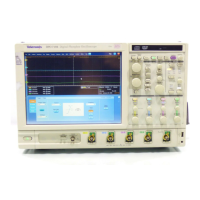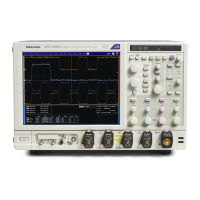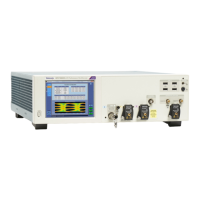Characterizing a signal. Signal characterization begins with taking measurements. To gain even more insight into your
measurements, you can add measurement statistics to calculate the average measurement value, the standard deviation, and
the maximum range of the measurement value.
Another way to characterize a signal is to compile a histogram from the acquired waveform. You can set up either a vertical
histogram to analyze amplitude values or a horizontal histogram to analyze timing. For example, the vertical histogram is useful
for characterizing noise and the horizontal histogram is useful for characterizing jitter.
While the histogram is being compiled from the acquired waveform, you can take continuous measurements on the histogram
data to determine its mean value and other useful statistics.
Application-Specific measurements. You can load optional measurement extensions as needed to enhance the capabilities of
the instrument for specific applications. These applications build on the precision signal acquisition performance of the instrument
to address your specific design requirements.
Here are some examples of the application packages:
■
Jitter and Timing Analysis. Use the DPOJET software to characterize the timing performance of semiconductor systems.
Analyze clock jitter, setup and hold times, and many other timing measurements on a cycle-by-cycle basis over long, single-
shot acquisitions. Measurement statistics are presented as numerical statistics, or graphically in a histogram, cycle trend,
time trend, or spectral plot.
■
Ethernet Compliance Testing. Use the ET3 software to perform 10/100/1000 Base T Ethernet compliance testing.
■
USB Signals. Use the USB or USB3 software to characterize USB 2.0 or USB 3.0 universal serial bus signals, including
mask testing and parametric testing.
■
Power Measurements. Use the DPOPWR software to quickly measure and analyze power dissipation in power supply
switching devices and magnetic components.
■
DDR Memory Bus Analysis. Automatically identify DDR1, LP-DDR1 DDR2, DDR3, and GDDR3 Reads and Writes and
make JEDEC conformance measurements with pass/fail results on all edges in every Read and Write burst.
■
MIPI
®
D-PHY Characterization and Compliance Testing. Verify to the D-PHY specification, rapidly characterize and
discover sources of jitter and signal integrity concerns.
■
SignalVu
™
Vector Signal Analysis. Easily validate wideband designs and characterize wideband spectral events.
■
CAN and LIN Timing and Protocol Decode Software. When you need to ensure seamless and reliable operation of a
CAN or LIN network, this option enables CAN bus triggering and provides the solution to measure oscillator tolerance,
propagation delay, and simultaneously decode CAN and LIN messages, with the protocol leveraging the trigger capabilities.
■
8b10b Serial Triggering and Analysis. Use the 8b10b software to trigger on and analyze 8b10b serial bus signals.
Additional packages may be available. Contact your Tektronix representative for more information.
About Tektronix oscilloscopes
DPO70000SX, MSO/DPO70000DX, MSO/DPO70000C, DPO7000C, and MSO/DPO5000B Series 67

